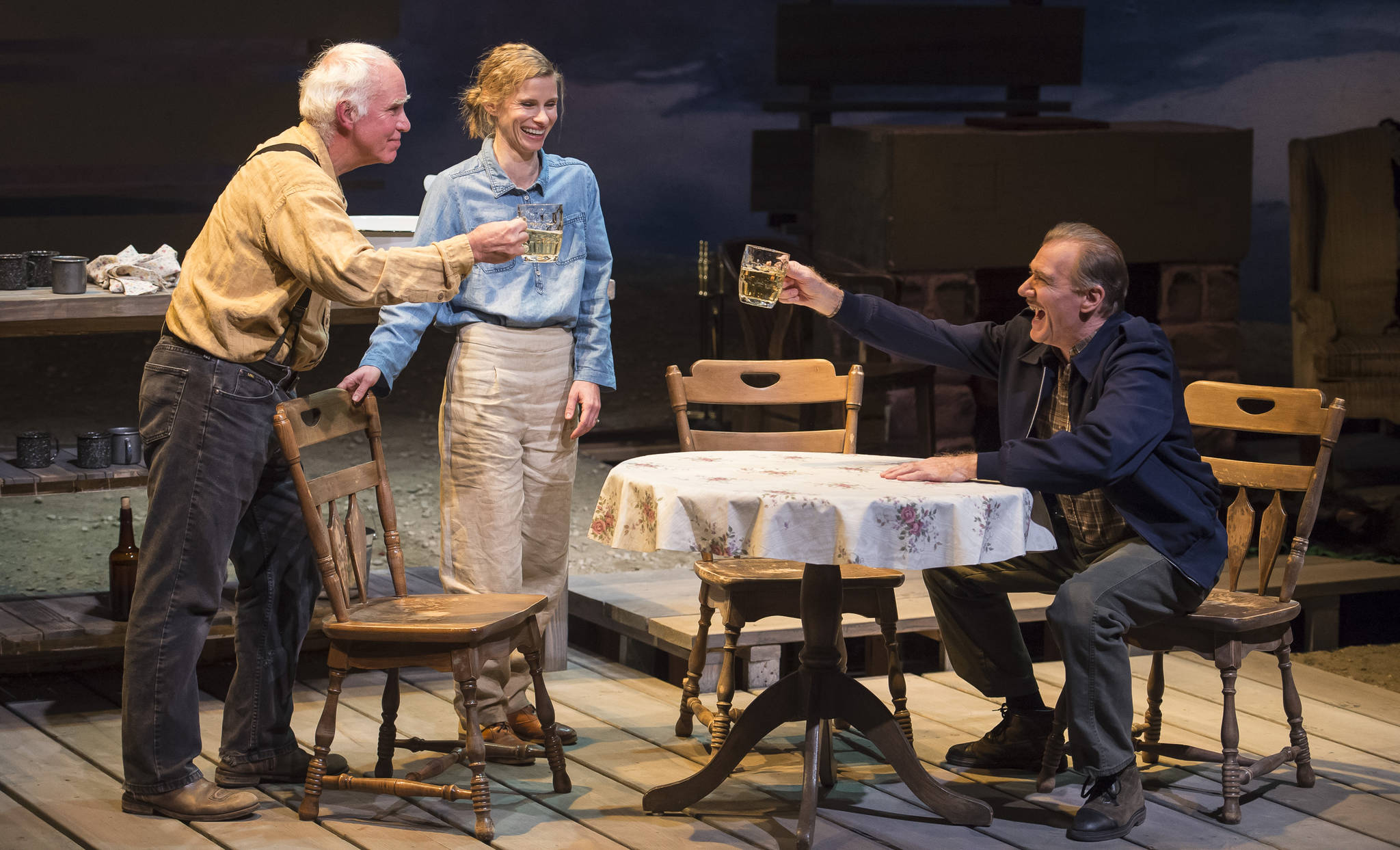The first thing to say about Perseverance Theatre’s latest offering, “Dreaming Glacier Bay,” a world premiere by Joel Bennett, is that the theatrical experience couldn’t be more different than the 2017-18 season opener.
Gone from the main stage is the professional wrestling ring from “The Elaborate Entrance of Chad Deity,” easily the biggest, loudest and, well, most elaborate non-musical production I’ve ever seen. In its place: the simple trappings of a remote cabin in Icy Strait, circa 1930.
There are no flashing lights, thumping music or smoke machines; only a washbasin, a woodstove, a table and chairs. The cast does not include any spandex-clad musclemen pretending to beat the heck out of each other with patented moves like the “Power Bomb” and “Sleeper Cell Kick.”
Rather, “Dreaming Glacier Bay” features two married couples doing pretty much all there is to do in a remote cabin in Icy Strait, circa 1930: drink homebrew and talk (and every so often toss another log on the fire). The only Power Bombs they deliver are verbal; any Sleeper Cell Kicks, emotional.
“Dreaming Glacier Bay” is Bennett’s debut as a playwright. A cinematographer by trade, he’s written, directed or shot nearly 30 films, and worked for more than a decade as cameraman on a British natural history television series.
Bennett draws inspiration from a series of yachting expeditions to Southeast Alaska in the late 1920s and early 1930s by movie star — and tabloid mainstay — John Barrymore.
A bit of context: part of a famed theatrical family (with a penchant for troubled marriages and substance abuse), John Barrymore not only ranked as Golden Age Hollywood’s preeminent leading man; his work as a Shakespearean actor also earned him the moniker “greatest living American tragedian.”
Of course, Barrymore’s personal life received equal, if not more attention. He struggled with alcohol from the age of 14, married and divorced four times, and ultimately died bankrupt in 1942.
John Barrymore wound up in the news cycle again two years ago, when a totem pole he stole in 1931 from the old village of Tuxecan on Prince of Wales was repatriated to Alaska. The totem pole’s mysterious disappearance and unexpected discovery 84 years later in a museum in Honolulu — it also spent a time as a yard decoration at Vincent Price’s mansion — served as the subject of various articles, most notably a lengthy profile in the “New Yorker” magazine (“The Movie Star and the Missing Totem Pole,” April 20, 2015).
While Perseverance bills “Dreaming Glacier Bay” as “a true Alaskan story with a mystery at its heart,” this is not that mystery. Instead, Bennett’s mystery involves Barrymore’s unlikely friendship with Muz and Joe Ibach, a real couple who farmed foxes, prospected for gold and homesteaded on Lemesurier Island.
Obviously, I don’t want to ruin any surprises. I’ll only say that the audience learns the mystery at the outset, then watches it revealed to the rest of the characters over the course of two well-paced acts.
By necessity, a more “quiet” play like “Dreaming Glacier Bay” derives its energy from its cast, crisply directed by Michael Evan Haney. Shelley Virginia shines as Muz Ibach, a homesteader with a past, as does Mike Peterson, who imbues the role of Joe Ibach with a certain polished roughness. Cate Ross returns to Perseverance as Dolores Barrymore, John’s third wife, caught between her own stardom, the demands of domestic life and an alcoholic egomaniac husband.
But Peter DeLaurier steals the show as John Barrymore — mostly because John Barrymore, himself, was a perpetual show stealer. DeLaurier’s Barrymore is boozily histrionic, a real-life Richard III who seems willing to trade his kingdom for anything he sees in front of him at the given moment.
Some may view this as a drawback. You may find it difficult to root for a main character who’s a jerk, and quite honestly, this John Barrymore is a huge jerk. There’s only so much one can care about whether he finds what he’s looking for; Joe and Muz already have, and Dolores is, both literally and figuratively, mostly along for the ride.
I’d be remiss not to mention the sets by scenic designer Dana Moran Williams, as well as the sound design by Lucy Peckham, both of which evoke Southeast Alaskan wilderness with simple elegance; the period music derives from a collection of 78 records belonging to the actual Muz and Joe Ibach, also a nice touch.
So there isn’t any wrestling. But “Dreaming Glacier Bay” still revolves around a larger-than-life character arriving in a giant yacht. If that’s not the elaborate entrance of a deity, I don’t know what is.
• Geoff Kirsch is a freelance writer living in Juneau.

